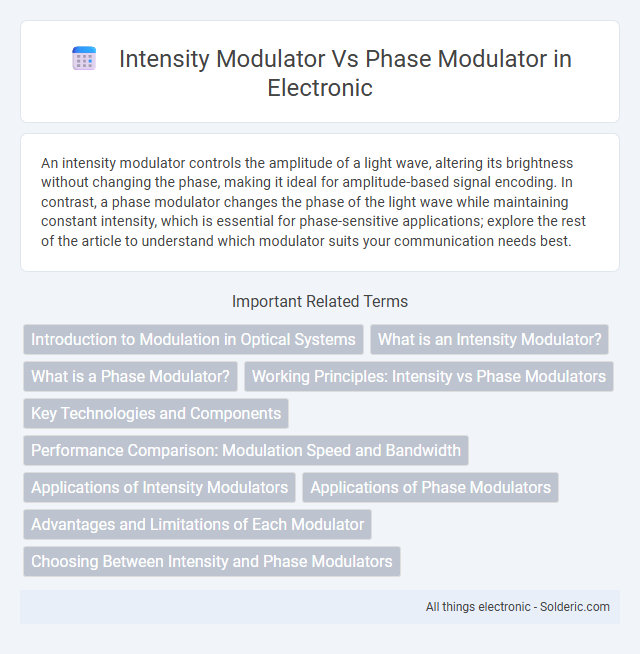An intensity modulator controls the amplitude of a light wave, altering its brightness without changing the phase, making it ideal for amplitude-based signal encoding. In contrast, a phase modulator changes the phase of the light wave while maintaining constant intensity, which is essential for phase-sensitive applications; explore the rest of the article to understand which modulator suits your communication needs best.
Comparison Table
| Feature | Intensity Modulator | Phase Modulator |
|---|---|---|
| Modulation Type | Amplitude modulation of light intensity | Phase modulation of the optical wave |
| Operating Principle | Alters light amplitude using electro-optic effect | Changes optical phase by varying refractive index |
| Typical Devices | Mach-Zehnder Intensity Modulator (MZIM) | Lithium Niobate Phase Modulator |
| Signal Type | Amplitude encoded signals | Phase encoded signals |
| Insertion Loss | Moderate insertion loss | Low insertion loss |
| Application | Optical communication amplitude modulation, pulse shaping | Phase encoding, coherent communication, advanced modulation formats |
| Bandwidth | Wide bandwidth, depends on device design | Wide bandwidth, generally higher than intensity modulators |
| Complexity | Relatively simple implementation | More complex driver and detection required |
| Linearity | Limited linearity in intensity variation | High linearity in phase modulation |
Introduction to Modulation in Optical Systems
Modulation in optical systems involves altering a light wave's properties to transmit information efficiently, primarily through intensity and phase modulation techniques. Intensity modulators control the amplitude of the optical signal, making them ideal for straightforward digital communication systems, while phase modulators manipulate the phase of light waves to enable advanced modulation formats like QPSK and QAM, which enhance data capacity and spectral efficiency. Selecting between intensity and phase modulation depends on the application's requirements for data rate, signal integrity, and resistance to noise and dispersion in fiber-optic communications.
What is an Intensity Modulator?
An intensity modulator controls the amplitude of an optical signal by varying its light intensity, typically using an electro-optic effect in materials like lithium niobate. It modulates the power of the light wave without changing its phase, making it ideal for applications such as optical communication where signal strength modulation is required. Its operation contrasts with phase modulators, which alter the phase of the optical wave for phase-based encoding schemes.
What is a Phase Modulator?
A phase modulator alters the phase of an optical signal to encode information, essential in coherent communication systems and advanced optical networks. It shifts the phase of the carrier wave without changing its amplitude, enabling higher spectral efficiency and improved noise resistance compared to intensity modulators. Phase modulation is critical in applications like quadrature phase-shift keying (QPSK) and differential phase-shift keying (DPSK) for high-speed data transmission.
Working Principles: Intensity vs Phase Modulators
Intensity modulators vary the amplitude of an optical signal by controlling the light intensity passing through a medium, commonly using electro-optic effects to attenuate or boost signal strength. Phase modulators alter the phase of the light wave without changing its intensity, shifting the optical signal's phase by inducing refractive index variations in the transmission medium. Your choice between intensity and phase modulators depends on the required application, such as amplitude modulation or phase-shift keying in optical communication systems.
Key Technologies and Components
Intensity modulators primarily rely on Mach-Zehnder interferometers and electro-absorption modulators to control the optical signal amplitude by varying light intensity. Phase modulators utilize lithium niobate (LiNbO3) or silicon-based waveguides to alter the phase of the optical wave through electro-optic effects without changing its intensity. Key components in intensity modulation include photodetectors and drive electronics for precise amplitude control, whereas phase modulation technologies emphasize voltage-controlled phase shifters and low-loss waveguide integration for high-speed signal processing.
Performance Comparison: Modulation Speed and Bandwidth
Intensity modulators typically offer higher modulation speeds and wider bandwidths compared to phase modulators due to their simpler design and direct control over light amplitude. Phase modulators, while providing precise phase control, often face bandwidth limitations imposed by material properties and electrode configurations. Your choice between the two depends on whether faster data transmission or detailed phase manipulation is prioritized in the optical communication system.
Applications of Intensity Modulators
Intensity modulators are widely used in optical communication systems for encoding information onto light signals by varying the amplitude of the optical carrier. They play a crucial role in fiber optic networks, enabling high-speed data transmission, pulse shaping in ultrafast laser systems, and signal processing in analog radar and LIDAR technologies. Their ability to efficiently convert electrical signals into optical intensity variations makes them indispensable in telecommunication infrastructure and advanced sensing applications.
Applications of Phase Modulators
Phase modulators are widely used in optical communication systems for phase shift keying (PSK) and coherent detection techniques, enhancing data transmission rates and signal integrity. They are essential in interferometric sensors and quantum key distribution (QKD) systems, where precise phase control enables high sensitivity and secure communication. Moreover, phase modulators support microwave photonics applications, including beam steering in phased array antennas and frequency comb generation for advanced spectroscopy.
Advantages and Limitations of Each Modulator
Intensity modulators offer straightforward implementation and high modulation speeds, making them ideal for digital communication systems; however, they suffer from amplitude noise and limited spectral efficiency. Phase modulators provide improved spectral efficiency and resistance to amplitude noise, enhancing signal integrity in coherent communication systems, but require more complex detection schemes and are sensitive to phase noise. Selecting between these modulators depends on system requirements such as bandwidth, noise tolerance, and compatibility with detection methods.
Choosing Between Intensity and Phase Modulators
Choosing between intensity and phase modulators depends on your specific application requirements such as signal quality, bandwidth, and noise tolerance. Intensity modulators control the amplitude of the optical signal, ideal for conventional communication systems needing straightforward modulation. Phase modulators alter the phase without affecting signal amplitude, offering advantages in coherent communication and advanced modulation formats for higher data rates.
Intensity modulator vs phase modulator Infographic

 solderic.com
solderic.com